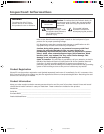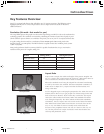
2
Introduction
Digital Signal and Sound
The analog television broadcast system that has been used in the United States for the past 50
years transmits signals as electronic waves. These waves can suffer degradation as the signal
travels to your home. Additionally, the analog waves are susceptible to interference from planes
passing overhead, weather, and household appliances.
Digital signals, in contrast to analog signals, can be reproduced precisely because the images
are transmitted and received using the computer language of 1s and 0s. Such precision yields a
signal that is capable of displaying studio-quality picture and Dolby Digital 5.1 channel sound.
Integrated HDTV Tuner with Digital Cable Ready QAM
RCA was the first to offer an integrated tuner with its HDTVs (which means there is no need for another
box to receive digital programming). Now, we’ve gone one better— your HDTV’s tuner is digital cable
ready (no need for a cable box to view unscrambled digital cable programming). The CableCARD™ slot on
your HDTV allows you to use a digital cable card to access digital cable. The tuner is able to decode all 16
formats of digital television broadcasts, and it can interpret unscrambled digital cable signals because it
includes QAM (Quadrature Amplitude Modulation).
Note: A digital cable card may be necessary to view scrambled (encrypted) channels. Contact your cable
provider for more information. Go to page 15 for more information.
TruScan Digital Reality
With the Film Mode option turned on, the intelligent signal processing of TruScan Digital Reality recognizes
incoming video signals and progressively converts them to achieve optimum digital picture performance. It
also recognizes when original film sources have been modified and can automatically convert the analog
frame rate back to its original format to bring out the detail--a process commonly referred to as reverse 3:2
pulldown.
Contrast
Color
Tint
Black Level
Sharpness
Auto Color
Color Warmth
Edge Enhancement
Contrast Expand
65%
70%
55%
60%
55%
On
Cool
Low
High
Contrast Expand
7
Advanced Settings
8
Edge Enhancement
6
Convergence
5
Color Warmth
4
Auto Color
3
Picture PresetsPicture Presets
2
Picture Settings
1
Go Back
0
Main Menu Picture Quality
You can choose the setting that is best for your viewing
environment. Press OK to continue.
A change in this screen is applied to Input 2.
Videogame
Cinematic (Night)
Natural
Vibrant (Day)
Professional
Personal
User-friendly Features Help You Personalize Your TV
•You can customize your TV to fit your viewing taste and match the lighting where
you watch TV by using Personal Presets and/or the automatic picture quality
settings: Vibrant (Day), Natural, Cinematic (Night), Videogame, Professional.
You can adjust each input jack to a different setting and the TV will automatically
adjust the picture when you change inputs.
•Help Text: The elaborate, on-screen help text describes your TV’s features and
explains how to use them.
Audio/Video Output Jacks
Because the VCRs in most households are analog and can’t receive or record digital TV
signals, recording digital TV broadcasts wasn’t possible without purchasing additional
equipment. That’s why RCA added AUDIO/VIDEO OUTPUT jacks to this HDTV.
These jacks enable you to record both analog and digital programs. RCA understands
how you watch TV and what’s necessary to make the transition to HDTV seamless.
CableCARD is a registered trademark of Cable Television Laboratories, Inc.
Help text
16339320.00 Intro 5/27/04, 4:03 PM2


















